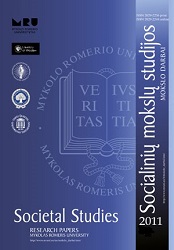Žmogiškieji ištekliai – svarbiausias konkurencinio pranašumo šaltinis strategiškai valdant organizaciją
Human Resources—Key Competitive Resources for Strategic Organization Management
Author(s): Margarita IšoraitėSubject(s): Business Economy / Management, Organizational Psychology, Human Resources in Economy
Published by: Mykolas Romeris University
Keywords: competitive advantage; human resources; human resources strategic management; human resource;
Summary/Abstract: In this article, by referencing scientific literature, human resources are analyzed as a key competitive advantage for the formation and management of strategic organization. This article analyzes the theoretical aspects of human resource management, the competitive advantages, and examines human resource strategic management theoretical models. According to scientific literature human resources management is not just the hiring and firing of personnel or social welfare. Human resources allow an organization to achieve its strategic objectives. Also, this article states that human resources are a competitive element, which is the most difficult to copy in an organization. The criteria of competitive advantage in human resources is strategically valuable, resources have a real advantage, they cannot be copied, rare, a unique competitive advantage. Human resource competitors recognize as important competitive advantage, which they cannot copy. Formation of the human resource management strategy follows such principles: 1. Institutions of philosophy, culture recognize human resources management strategy is one of the elements, which each must be aligned to. 2. Institutions and human resource management strategy must adapt, because human resource strategy is important for the institution strategy. 3. Human resource management strategy highlights the social objectives of the staff. 4. Human resource management strategy includes: safe working and social conditions of production and protection, work arrangements among different groups of staff—managers, professionals, workers’ protection, owners or shareholders and staff coordination of interests, optimizing the potential of staff, emphasizing the priority of workers’ interests, emphasizing the social dimension of the issue, reasons of staff productivity and efficiency. The article also analyses the following human resource management models—Michigan Business School Human Resource management model, Guest model, Warwick model and the Harvard model. It also provides empirical research concerning respondents’ views on human resources as a key source of competitive advantage for strategic organization management. According to application results the most intangible motivation tools for the respondents are career development, recognition of their work, good managing and management style, employee outcome assessment, accountability and empowerment of employees, opportunities for continuous improvement, training. The most tangible motivation tools for the respondents wage, bonuses, insurance against accident at work, office telephone calls and pay bills. Staff is still not sufficiently involved in the decision-making process. According to respondents the competitive advantage to the company gives such benefits as rising corporate profits, turnover, increased number of clients, the more satisfied the needs of clients, increasing value of company and etc. The respondent company’s competitive advantage is perceived as elements of their relationships with customers, customer service, marketing, fast response to customer needs, the importance of productive capacity, their image, human resources, innovation, speed, knowledge and information, organizational learning, organizational culture, the local utility, strategic goals and objectives, flexibility, companies belonging to the network. Respondents consider the factors affecting long-term competitive advantage of companies in the field of human resources is high-security conditions of employment, high wages, good communication and great respect for the personality, training, operational review and setting goals and objectives, job description, skilled manual labour, vision, and employee involvement in the decision-making process. Thus, the analysis of scientific literature shows strategic management of an organization as a source of competitive advantage—human resources interface with the organization’s sources of competitive advantage, such as speed of innovation, knowledge and information, organizational training, marketing, organizational culture, the local utility, strategic goals and objectives, flexibility, while companies belonging to the network are carried, controlled and deployed by the same people.
Journal: Socialinių mokslų studijos
- Issue Year: 3/2011
- Issue No: 1
- Page Range: 31-58
- Page Count: 28
- Language: Lithuanian

